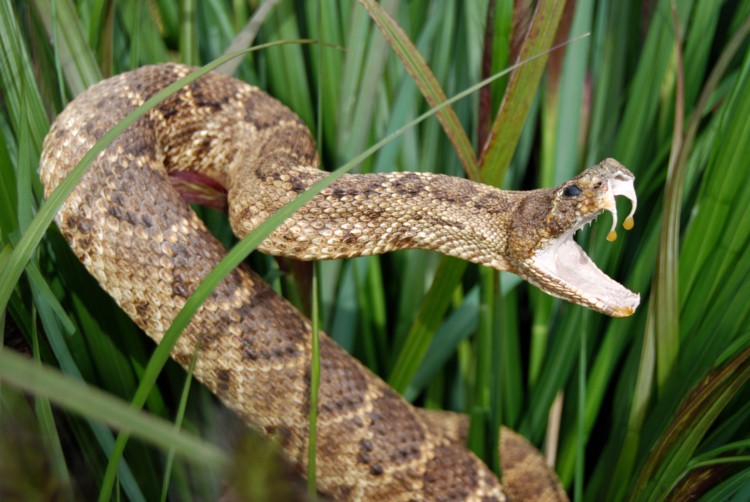Shelly Sinclair, shsinclair@davidson.edu
This web page was produced as an assignment for an undergraduate course at Davidson College.
Click here to visit our homepage.
Comparative transcriptomics revealed a conserved gene regulatory network in snakes that suggested an origin point and possible evolutionary mechanisms for oral venom systems.
Evolution and the biological systems undergoing different evolutionary changes within species depend on ecological conditions. Some evolutionary changes involve weaponizing biological systems within species as a response to harsh ecological conditions, such as the development of different oral venom systems. Venoms are a mixture of proteins that are associated with distinct gene networks in amniotes (which references mammals, birds and reptiles) (Duda and Palumbi, 2000). The use of toxins within the oral venom system for both defense and attacking prey has undergone different evolutionary mechanisms across different species (Mailho-Fontana et al. 2020). For instance, amniotes show diverse venom systems across species of snakes, lizards and some mammals (Barua and Mikheyev, 2021). While some lizards and snakes rely on prey immobilization for attacking, each species uses different toxins for that process. The fact that these oral venom systems can be traced genetically due to distinct gene networks is an advantage in identifying the origin and evolutionary mechanisms of oral venom systems. However, research on toxins have shown that they undergo rapid evolutionary changes, show complex patterns of expression and were only recently incorporated into the oral venom system (Barua and Mikheyev, 2021). For example, in regard to the difficulty of tracking the origin and evolutionary mechanisms of toxins, gene duplication is effective in increasing the amount of protein in tissues used for venoms which gives rise to different levels of gene expression in response to varying ecological conditions (Moran et al. 2008). Further, the origin and evolution of toxins may be more common and less distinctive across species than previously understood.
Understanding the origin and evolution of oral venom systems is significant because biological systems in species are not isolated and all interact with each other within different cellular processes. The research article, “An ancient, conserved gene regulatory network led to the rise of oral venom systems”, found that a conserved gene regulatory network associated with toxin-producing genes in snakes was also present in other amniotes such as lizards and mice. The researchers suggested that cooption of shared cellular processes blurs the line separating venomous animals from their nonvenomous ancestors. Using an existing gene network and changing it via the recruitment of toxin-producing genes is an example of a process known as exaptation; this is exhibited by venomous animals such as snakes (Barua and Mikheyev, 2021). The conserved gene regulatory network seen in snakes and mammals was confirmed via comparative transcriptomics. This is a genomic method that compares transcriptional data from different species and show commonalities that reflect evolutionary conserved gene networks. The gene co-expression networks characterized which genes are associated with venom production, later termed as the meta-venom network, and their biological role (Barua and Mikheyev, 2021).

The results of the research suggested that salivary glands in mammals and venom glands in snakes share a functional core derived from a common ancestor (Figure 1). This was deduced from the conserved expression of the meta-venom network between the two glands of the two species (Barua and Mikheyev, 2021). For instance, snakes use an oral venom system for securing prey and mammals, such as shrews, have evolved oral venom systems for prey capture or defense (Barua and Mikheyev, 2021). Using this meta-venom network, snakes diversified their oral venom system by incorporating novel toxins while mammals maintained a more simplified process that is similar to saliva (Figure 2). These alternate evolutionary pathways led to large phenotypic changes and functional shifts between the two lineages, but the common ancestor remains. Within snakes and other venomous species, genes within their genome have undergone greater expansions and more rapid evolution to better adapt and better equip their oral venom system. This comparative study confirms that venomous and nonvenomous species are more similar than previously thought and a likely origin point based on the meta-venom or conserved gene regulatory network.
This research has a larger significance based off of understanding and uncovering origins and evolutionary mechanisms of biological systems. Organisms typically show combinations of ancestral and derived characteristics within the genome (Barua and Mikheyev, 2021).. Comparing existing organisms shows combinations of shared ancestral and splitting characteristics within a lineage. While this research elucidated the gene network of a common ancestor, there are still many unanswered questions regarding this study. For instance, the researchers emphasize the ecological importance of oral venom systems but have not identified which ecological conditions necessitated the incorporation of toxins into amniotes like snakes but not in mammals such as mice. Further, the researchers deduced different possible evolutionary mechanisms for the rise of these oral venom systems in snakes but were unable to confirm the exact mechanism used nor did they confirm at what point did the split of oral venom systems occur. The study has elucidated much in regard to coopting evolutionary mechanisms, but more research is needed to understand the origin and evolution of venom.
© Copyright 2021 Department of Biology, Davidson College, Davidson, NC 28036

